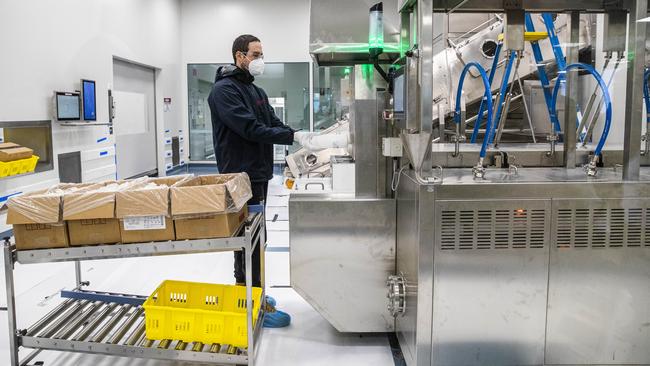CSL shares dive 7pc on $370m foreign currency hit, while FY24 profit forecast misses consensus estimates
Joy Linton, chief financial officer of the ASX-listed health titan, says it will be ‘some time’ before margins return to pre-pandemic levels.
CSL expects a profit hit of up to $US250m ($369.5m) this year - citing a strengthening US dollar against major currencies - and the pain is expected to continue next year, with the company slashing $US500m off consensus estimates in its forward guidance.
The biotech titan revised its earnings forecast on Wednesday, sparking a 6.9 per cent slump in its share price to $287.25 on Wednesday – a two-and-a-half month low. This compares to a 0.3 per cent fall across the broader share market.
Chief financial officer Joy Linton said on a constant currency basis, the company expected to maintain its earnings guidance for this financial year, “albeit now skewed to the top end of the range”. But it is, the 2024 financial year forecast of $US2.9-$US3bn was dramatically below consensus estimates of $US3.5bn.
It comes as the US Federal Reserve’s aggressive interest rate hikes have spurred a historic rally in the greenback to multi-decade highs against currencies such as the euro and yen. While the US dollar has fallen more than 10 per cent since its peak in September, its rampant rise dramatically altered CSL’s currency headwind expectations.
Previously, the company was expecting a currency hit of $US175m, but that has now stretched out to as high as $250m.
“I recognise that analysts tend to use house views on currency expectations. However, at any point in time, our numbers are based on the assumption that rates remain steady throughout the financial year,” Ms Linton said.
“The second point I want to make on currency is that CSL Behring has about 50 per cent of our sales outside the US and yet the majority of costs are in US dollars, and this comes with some counterintuitive impacts,” Ms Linton said.
“If the cost of production changes in one year, it doesn’t have a margin impact until year two when the product is sold and that is a function of our long manufacturing cycle. However, if the price of a product changes, we see the P & L impact in the same year and this creates a timing mismatch between the impact of input cost and sales.”

Ms Linton said the two biggest currency movements the company has battled is the US’s appreciation against the euro and Chinese yuan.
“They were the two biggest components and in the second half of the year – or from December through to about May – which gives us this higher forecast – really the euro actually slightly improved and there really hasn’t been much movement in the yuan, but we’ve booked that in the first half of the year, so that sort of still held true.
“Our geographic diversification of sales is actually one of our strengths. It not only provides us with financial diversification but puts us in a position to be able to help more patients around the globe. But a volatile currency environment helped … over the last year or so.”
Traders have priced in a 93 per cent chance that the Fed will pause interest rates at the 5-5.25 per cent range on Wednesday, they are pricing in a 62 per cent chance of a 25-basis-point hike in July.
Ms Linton said she expected costs to fall 15-20 per cent by the end of the financial year, but that was not enough to return CSL Behring’s margin to pre-pandemic levels.
“We will need other drivers to help get us there and these include operational efficiencies, both in terms of manufacturing and in our plasma centres, and manufacturing yield improvements particularly in IG (immunoglobulin), the launch of new products along with some modest priced product price increases along the way.
“All of this will take some time, particularly in the high current inflationary environment and the foreign exchange realities, but I will say that we fully expect the CSL Behring and gross margin to return to pre Covid levels in the medium term.”
Despite the pandemic subsiding, plasma donor fees remain high - a situation Ms Linton said the company could not reverse easily.
“Donor fees and labour costs have increased across the industry. Now Covid is receding, it is not a simple matter of just reducing donor fees. We still still need to compete for donors. In fact, as we’ve said previously, it is unlikely that donor fees will ever go back down to pre-Covid levels.”
RBC Capital Markets’ Craig Wong-Pan said while CSL’s FY23 earnings were tracking in line with consensus, its FY24 guidance of $US2.9-3bn was lower than expected. He was previously forecasting next year’s profit to be $US3.8bn, against consensus estimates of $US3.5bn.
“Management provided a long list of key variables that may have a significant impact on guidance,” Mr Wong-Pan said.
“However, we expect the large miss to FY24 NPATA forecasts to be taken negatively by the market.”






To join the conversation, please log in. Don't have an account? Register
Join the conversation, you are commenting as Logout